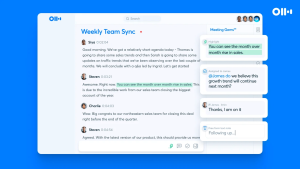In an age where technology continually evolves, the integration of artificial intelligence (AI) into various aspects of our professional lives is becoming increasingly prevalent. One such area is AI meeting transcription, where advanced algorithms can automatically convert spoken words into text. While this technology offers numerous advantages, it also raises significant privacy considerations. This article explores the critical privacy aspects associated with AI meeting transcription.
Data Security and Confidentiality
Protection of Sensitive Information
When utilizing AI for transcribing confidential meetings, one of the foremost concerns is the protection of sensitive information. Discussions involving proprietary strategies, financial data, or personal matters need to be safeguarded at all costs. Ensuring the AI transcription service provider has robust security measures in place is paramount. This may include encryption protocols, access control mechanisms, and regular security audits to mitigate data breaches.
Compliance with Data Regulations
AI meeting transcription must align with data protection laws and regulations. Compliance with laws such as the General Data Protection Regulation (GDPR) or the Health Insurance Portability and Accountability Act (HIPAA) is non-negotiable. Failure to do so can result in severe penalties and damage to the reputation of the organization.
Ethical Considerations
Informed Consent
Recording meetings for transcription purposes should only be done with informed consent from all participants. Participants need to be aware that AI technology may be employed and understand the implications for privacy. Transparency in this regard is essential.
Anonymization and Redaction
To enhance privacy, AI transcription systems should offer features for anonymization and redaction. This means the removal or replacement of personally identifiable information (PII) and confidential details within the transcripts. These features can reduce the risk of unintended data exposure.
AI Meeting Transcription Software Selection
Selecting the right AI meeting transcription software involves balancing various factors:
Cost and Budget
The cost of AI transcription services can vary significantly. Organizations should assess their budget constraints and choose a solution that aligns with their financial resources. Comparing pricing plans and considering any additional charges for customization is crucial.
Efficiency and Speed
Efficiency is critical, especially in time-sensitive scenarios. Evaluate the transcription speed of the AI system. Some services offer real-time transcription, which can be a game-changer for certain industries.
Quality and Accuracy
Transcription accuracy is paramount, particularly for confidential meetings. Assess the system's quality through trial runs and customer reviews. A higher-quality transcription may justify a slightly higher cost.
Hardware and Software Specifications
Consider the hardware and software requirements of the AI transcription system. Ensure compatibility with existing infrastructure and assess any necessary upgrades or investments.
Lifecycle and Maintenance
Longevity and Lifespan
Evaluate the AI transcription system's expected lifespan and the vendor's commitment to updates and maintenance. A longer lifespan can justify a higher initial investment.
Value and Time Efficiency
Consider the overall value provided by the AI transcription solution. Calculate the time saved in manual transcription and weigh it against the cost.

Pros and Cons
For a comprehensive understanding of the AI meeting transcription technology, here is a breakdown of the pros and cons:
Pros:
- Increased transcription speed, reducing manual effort.
- Improved accuracy and reduced human error.
- Potential for real-time transcription.
- Enhanced searchability and indexing of meeting content.
Cons:
- Initial implementation costs can be high.
- Potential security and privacy risks if not handled correctly.
- Dependence on technology may lead to skills erosion among human transcribers.
- Customization for specific industry jargon may be necessary, incurring additional costs.
For further insights into choosing the right meeting transcription software and balancing these pros and cons, you can refer to this external resource.
In conclusion, while AI meeting transcription offers undeniable advantages, organizations must be diligent in addressing privacy concerns, ensuring data security, and making informed decisions when selecting transcription software. The benefits of efficiency and accuracy can be realized, but only with a thorough understanding of the associated privacy considerations and a commitment to ethical usage.